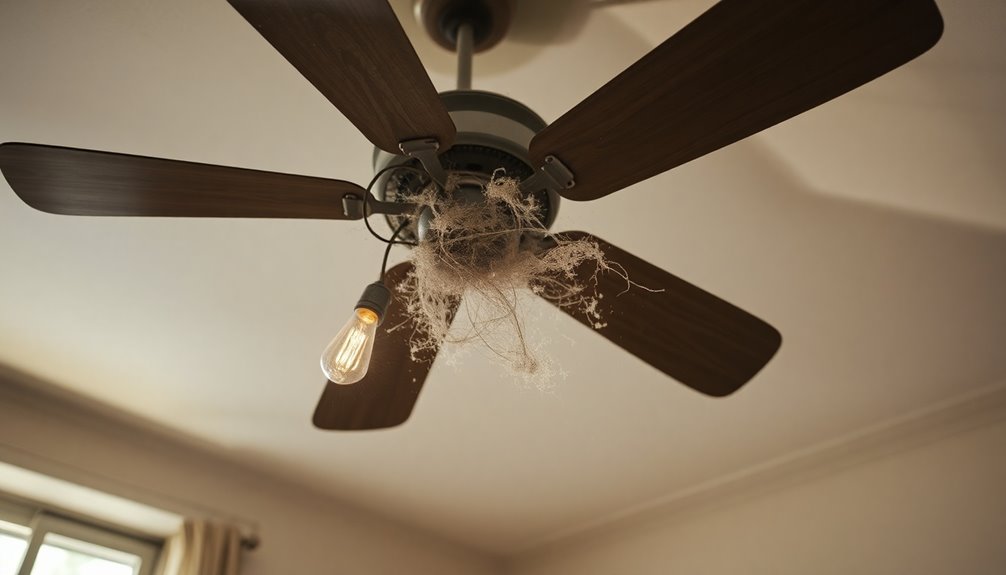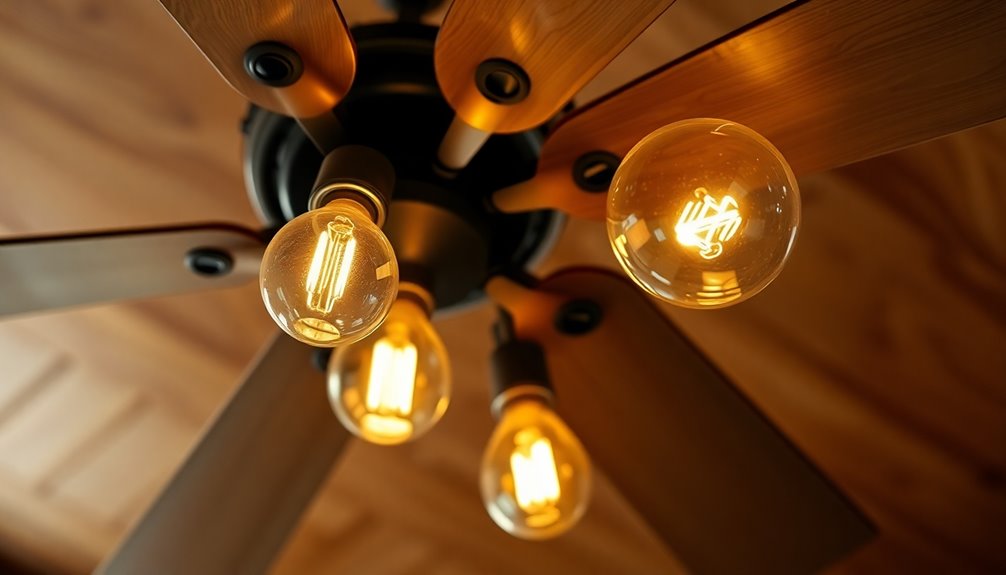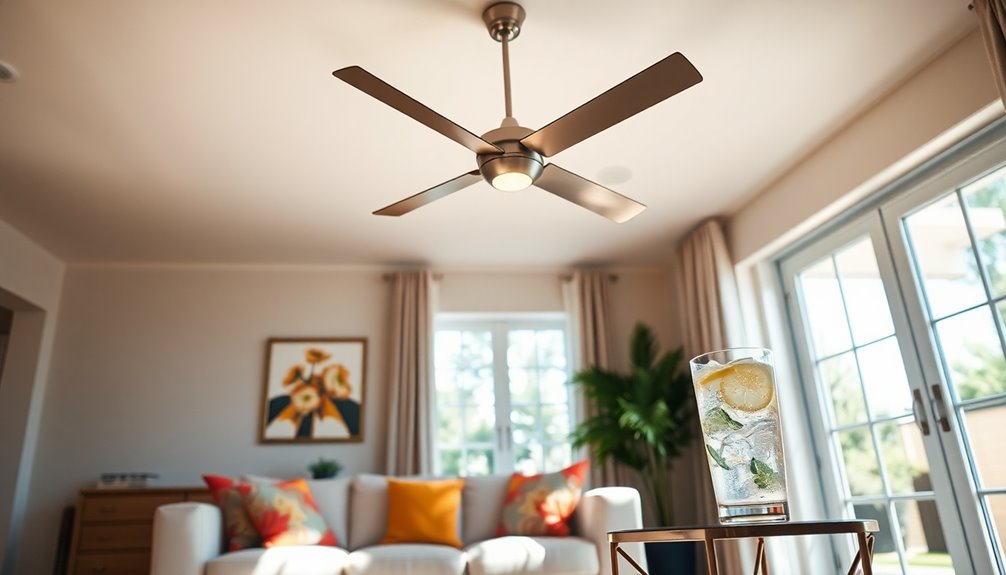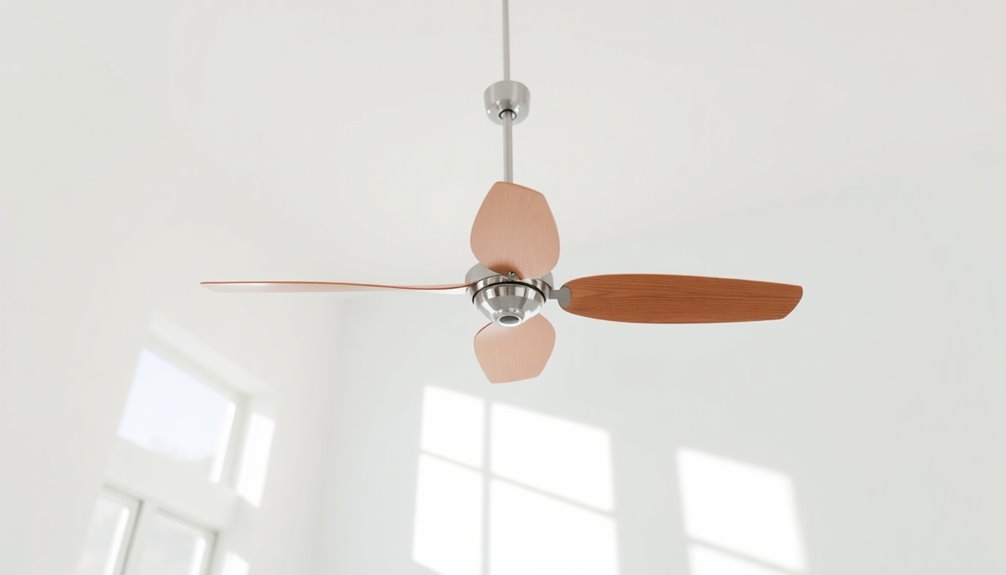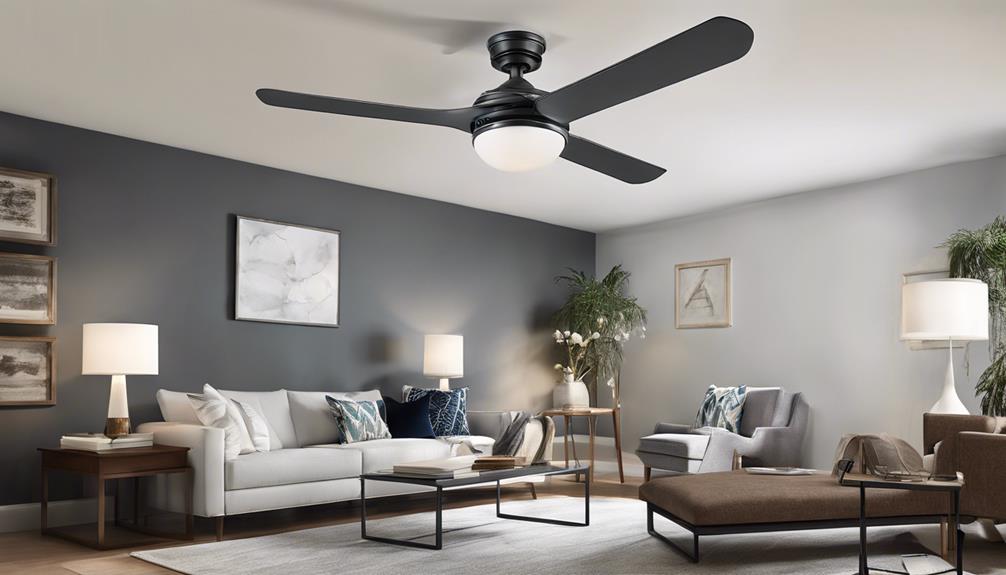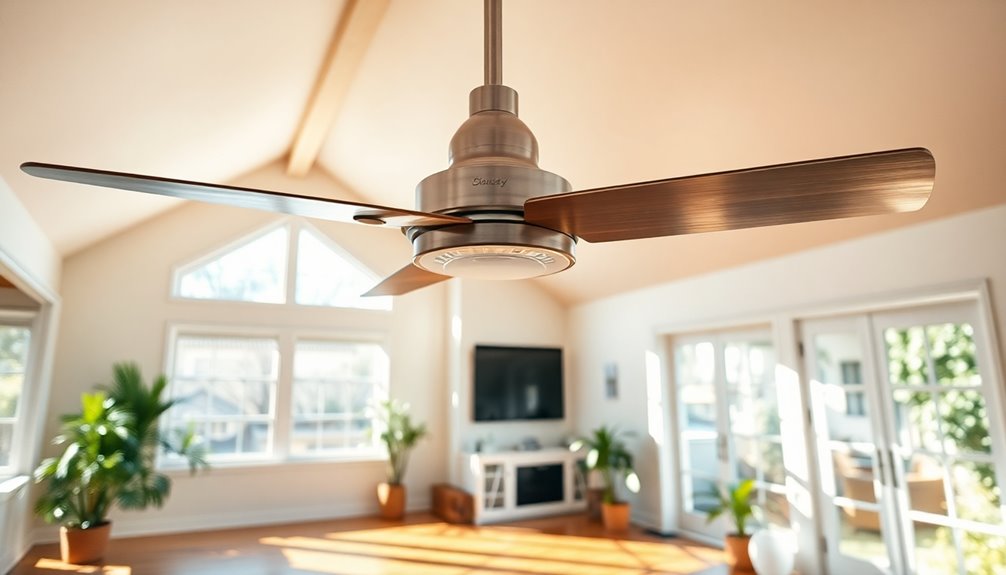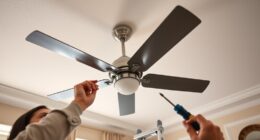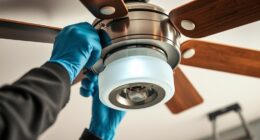If your ceiling fan isn't working, it could be due to several common issues. Start by checking the power supply; tripped circuit breakers or loose wiring might be the culprits. A burnt capacitor can also prevent the fan from operating. Make sure the wall switch is on and the remote control's batteries are fresh. Inspect the fan for any damaged blades or electrical connections. If the fan still won't operate, the problem could lie deeper within the motor or control circuit. There's more to explore on how to troubleshoot and fix these issues effectively.
Key Takeaways
- Check for tripped circuit breakers, as they can interrupt the power supply to the fan.
- Inspect wiring connections for looseness, damage, or fraying that could hinder electrical flow.
- Ensure the wall switch is in the "ON" position and that remote control batteries are functioning.
- Test the fan's capacitor and motor for faults, as burnt capacitors often prevent operation.
- Look for power supply issues, such as voltage fluctuations or power surges, which can damage components.
Causes of Ceiling Fan Malfunction

When your ceiling fan isn't working, it's often due to several common issues. One of the first things to check is loose wiring or faulty wiring connections, which can disrupt the power supply to the fan. Without a steady power source, your ceiling fan motor may not function correctly.
Another common culprit is a burnt capacitor, which can prevent the motor from turning at all. You should also consider the impact of insufficient power supply, often caused by voltage fluctuations or tripped circuit breakers. If the breaker has tripped, you'll need to reset it to restore functionality.
Additionally, inspect the fan blades. Damaged or unbalanced fan blades can lead to inefficiency, noise, or complete failure to operate. An unbalanced fan can also strain the motor, leading to a motor malfunction over time.
Troubleshooting Steps to Take

To get your ceiling fan working again, start by checking the power supply.
Inspect the circuit breaker for any tripped switches, and make certain the wall switch is turned ON.
If everything looks good there, take a closer look at the wiring connections to confirm they're secure and intact. Additionally, ensure that your ceiling fan is compatible with smart home compatibility if it has advanced features that require specific settings.
Check Power Supply
One of the first steps in troubleshooting a ceiling fan that isn't working is checking the power supply. Start by inspecting the circuit breaker or fuse box to make certain the power supply is active. If the circuit has tripped or a fuse has blown, reset it or replace the fuse to restore power to the fan.
Next, grab a circuit tester or multimeter to confirm that power is reaching the fan's wiring. Loose or damaged wiring can hinder operation, so verify connections are secure.
Don't forget the wall switch—make sure it's in the "ON" position. Sometimes, it's as simple as inadvertently turning it off. If your fan uses a remote control, consider replacing the batteries to rule out low power issues affecting functionality.
Additionally, evaluate whether the fan is on a dedicated circuit. If it's sharing a circuit with other devices, you may encounter electrical issues that need further investigation.
Inspect Wiring Connections
Before diving into wiring connections, turn off the power to the ceiling fan at the circuit breaker for your safety.
Now, carefully remove the switch housing cover to access the wiring. This step is vital in your ceiling fan troubleshooting process. Inspect wiring connections for any loose, damaged, or frayed wires that could disrupt electrical flow.
Using a multimeter, test the continuity of the wiring connections. This will help you confirm that power is reaching the fan's motor and switches. Look for any signs of damaged wiring that might be causing a wiring issue.
Verify all wire nuts and connectors are securely fastened; exposed wires can lead to shorts or electrical failures, so it's important to check for those too.
If you've secured all connections and the fan still isn't working, don't hesitate to consult a professional electrician. They can address deeper wiring problems that may be beyond a simple DIY fix.
Electrical Failures and Solutions

When your ceiling fan stops working, electrical issues could be the culprit.
You might encounter problems like loose wiring, a burnt capacitor, or insufficient power supply.
Let's explore how to troubleshoot these common electrical failures and when to call in a professional for help.
Common Electrical Issues
Electrical failures can be a major headache, especially when your ceiling fan suddenly stops working. One common culprit is tripped circuit breakers, which interrupt the power supply to the fan. A quick reset can often restore functionality.
If that doesn't solve the issue, check for loose wiring connections, either within the fan or at the switch. Faulty wiring can prevent power from reaching your ceiling fan, so it's vital to inspect and tighten or replace any problematic connections.
Another potential issue is a neutral line failure, which can affect both the fan and the light simultaneously. In such cases, diagnostic testing is important to isolate the problem.
Power surges can also wreak havoc on your ceiling fan, damaging internal components like control circuit boards in certain brands. If you suspect damage, you may need to replace these parts to get your fan running again.
Before diving into fan-specific troubleshooting, test the power at the switch using a power line wire test probe. This helps confirm whether electrical issues exist upstream, guiding you to the right solution for your ceiling fan not working.
Troubleshooting Power Supply
Power supply issues can be frustrating, especially when your ceiling fan won't turn on. Start your troubleshooting by checking the circuit breaker; if it's tripped, it may have interrupted the power supply to the fan.
If the breaker is fine, inspect the wiring connections within the fan housing. Loose or damaged wires can disrupt the electrical flow and prevent the fan from operating.
Next, grab a circuit tester to verify that power is reaching the fan. If no power is detected, the problem could be with the fan switch or the electrical supply.
Don't forget to check that the fan switch is fully engaged and in the "ON" position; this is a common oversight that can easily stop the fan from running.
If your ceiling fan is on a dedicated circuit, make sure no other devices on that circuit are drawing excessive power. This can cause voltage fluctuations that affect the fan's performance.
Professional Help Needed
If basic troubleshooting doesn't resolve the issue with your ceiling fan, it's time to contemplate that the problem might be more complex than a simple power supply failure.
Electrical failures can stem from various sources that require the expertise of a licensed electrician. Here are some common issues that might necessitate professional help:
- Faulty Wiring Connections: Loose or damaged wires can disrupt the power supply and lead to malfunctioning. Proper maintenance of electrical components, similar to how one maintains air purifier filters, is essential for preventing such issues. Regular inspections can help identify air quality problems that may affect electrical systems. Additionally, ensuring that the wiring is not exposed to dust and debris can further safeguard against electrical failures. Furthermore, compliance with local fire safety codes is crucial to avoid electrical hazards when dealing with wiring.
- Burnt Capacitors: These components store energy and can fail over time, causing the fan to stop working.
- Damaged Motor Components: A malfunctioning motor can result from wear and tear or power surges, requiring replacement.
Attempting to fix complex wiring issues without proper knowledge can create safety hazards and further damage your ceiling fan. Additionally, ensuring that your home has good ventilation practices can help mitigate some electrical issues related to air quality, which might indirectly impact your ceiling fan's performance.
Compliance with electrical safety regulations is essential for ensuring that all repairs are performed according to local codes.
If you suspect that your ceiling fan might've deeper issues, don't hesitate to seek professional help. A qualified technician can diagnose and resolve the problem safely, restoring your fan to proper working condition.
Issues With Fan Speed Control

When dealing with issues related to fan speed control, you might find that the culprit often lies with the capacitor. A faulty capacitor can prevent your fan from adjusting speeds properly, leading to inconsistent fan speed and even overheating. Additionally, problems with the fan switch can hinder your ability to change speeds. Testing the switch functionality with a multimeter is vital to identify any faults.
Electrical connections are another significant area to inspect. Damaged connections can disrupt the signal for speed control, necessitating inspection and repair to guarantee peak performance. Regular maintenance is essential; cleaning and lubricating ball bearings can help prevent speed-related issues before they escalate.
Here's a table summarizing common issues and their solutions:
| Issue | Solution |
|---|---|
| Faulty Capacitor | Replace the capacitor |
| Worn Ball Bearings | Clean and lubricate |
| Fan Switch Malfunction | Test with a multimeter |
| Damaged Electrical Connections | Inspect and repair |
Common Brand-Specific Considerations

Many ceiling fan brands come with specific quirks that can affect their performance and maintenance. Understanding these nuances can save you time and frustration when troubleshooting your ceiling fan.
Here are three key considerations to keep in mind:
- Wiring Configurations: Brands like Casablanca may have unique wiring setups. Always refer to the manufacturer's documentation for specific troubleshooting steps to avoid improper repairs.
- Remote Control Issues: Certain brands often face problems with remote control receivers, particularly after power surges. If your fan isn't responding, check if the receiver needs replacement.
- Control Circuit Boards: Fans from manufacturers like Hunter might experience frequent electrical failures due to faulty control circuit boards. If you suspect this, consult the troubleshooting steps in your documentation to determine if replacement parts are necessary.
When to Seek Professional Help

Some situations clearly call for professional help, especially when dealing with ceiling fan issues. If your ceiling fan stopped working and basic troubleshooting hasn't resolved persistent fan problems, it's time to evaluate a professional assessment. Complex wiring issues or internal parts failures, like a faulty motor or a capacitor that goes bad, can pose safety risks if you attempt repairs without the right expertise. Additionally, understanding filial responsibility laws can help in planning for future financial needs that may arise from home maintenance costs.
Here's a quick reference to help you decide when to contact a licensed electrician:
| Situation | Action Needed | Recommendation |
|---|---|---|
| Ceiling fan stopped working | Troubleshoot a ceiling fan | DIY basics first |
| Unusual noises or non-spinning | Persistent fan problems | Consult a professional |
| Complex wiring issues | Electrical components involved | Contact a licensed electrician |
| Suspected internal part failure | Faulty motor or capacitor goes bad | Seek professional help |
| Lack of tools or comfort | Handling electrical components | Hire a qualified technician
Frequently Asked Questions
Why Would a Ceiling Fan Just Stop Working?
A ceiling fan might just stop working for several reasons.
You could have loose or faulty wiring connections disrupting the power supply. It's also possible that a burnt capacitor is preventing the motor from functioning.
If you've tripped a circuit breaker, that'll interrupt power until you reset it.
Additionally, mechanical issues like damaged blades can hinder performance, causing the fan to stop altogether.
Check these factors to pinpoint the problem.
How Do You Fix a Ceiling Fan That Won't Turn?
Imagine standing beneath a ceiling fan, hoping for a cool breeze, but nothing happens.
To fix it, start by checking the power supply—ensure the circuit breaker hasn't tripped and all switches are on.
Next, inspect the wiring inside the fan for any loose connections.
If you've got a remote, replace the batteries.
If it still doesn't turn, you might need to replace a burnt capacitor or consult a professional.
What Is the Common Problem of a Ceiling Fan?
When you think about common problems with ceiling fans, several issues might come to mind.
You might notice electrical failures, like tripped breakers or loose wiring, which can prevent the fan from receiving power.
Unbalanced or damaged blades could make it wobble and operate inefficiently.
You should also consider a faulty capacitor, which might restrict speed or prevent the motor from starting.
Finally, remote control issues could hinder functionality, often due to dead batteries.
Why Is My Ceiling Fan Light Not Turning On?
You walk into the room, expecting the comforting glow of your ceiling fan light, but nothing happens.
First, check if the light switch is on—sometimes it's the simplest things.
If it is, try replacing the bulbs; they might be burned out.
Inspect the fixture for loose connections.
If you're using a remote, don't forget to check the batteries.
If all else fails, the manual might hold the key to your mystery.
Conclusion
To summarize, if your ceiling fan isn't working, identifying the cause is key to getting it back in action. Remember, about 30% of ceiling fan issues stem from electrical failures. By following troubleshooting steps and considering brand-specific quirks, you can often resolve the problem yourself. However, don't hesitate to call a professional if you're uncertain or if the issue persists. Keeping your fan in good shape can enhance airflow and comfort in your home!
